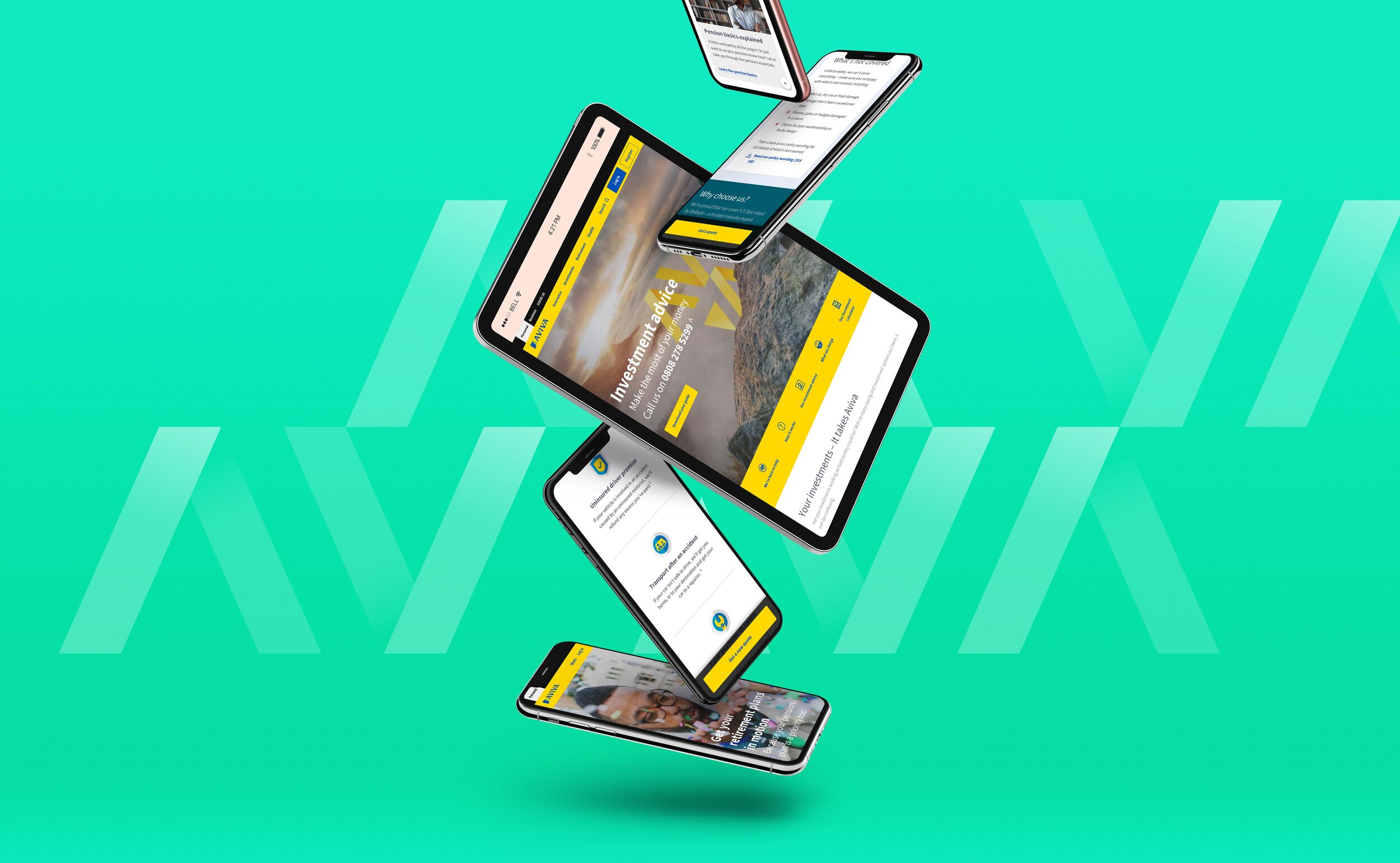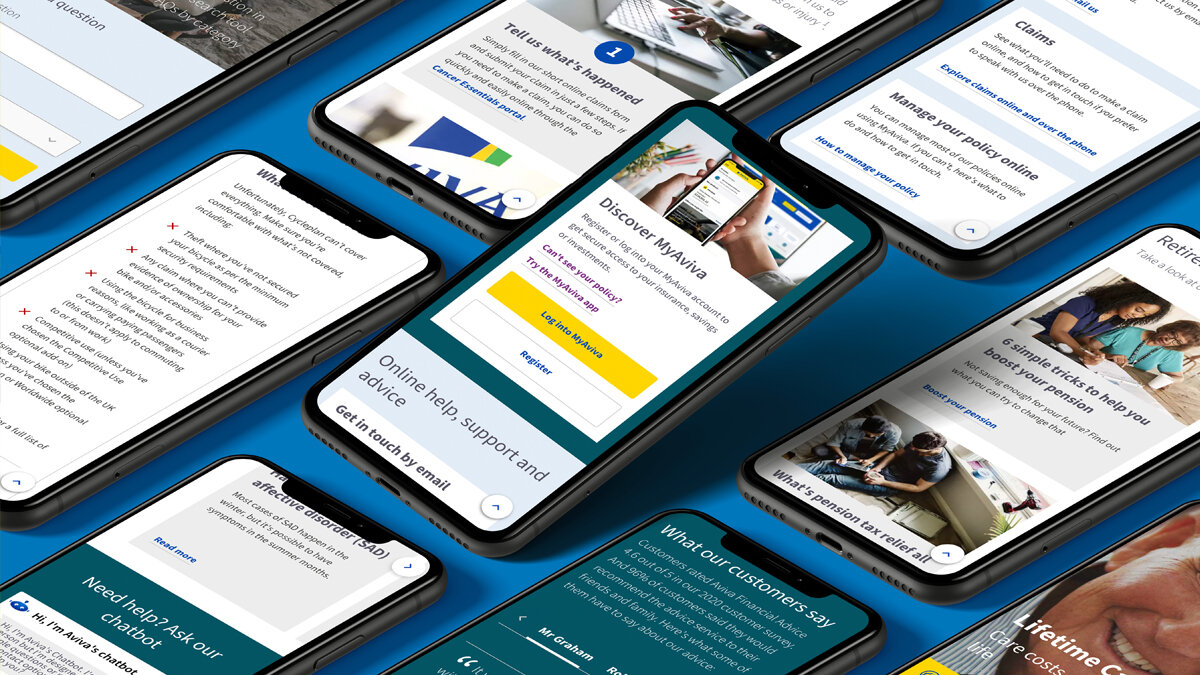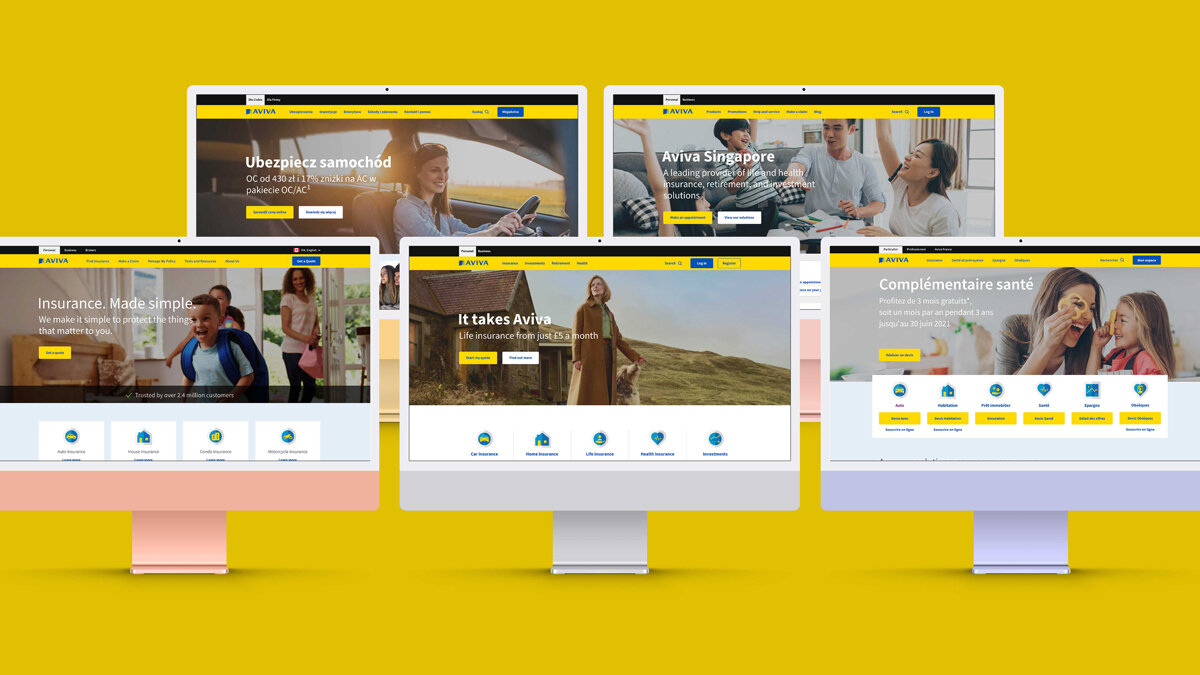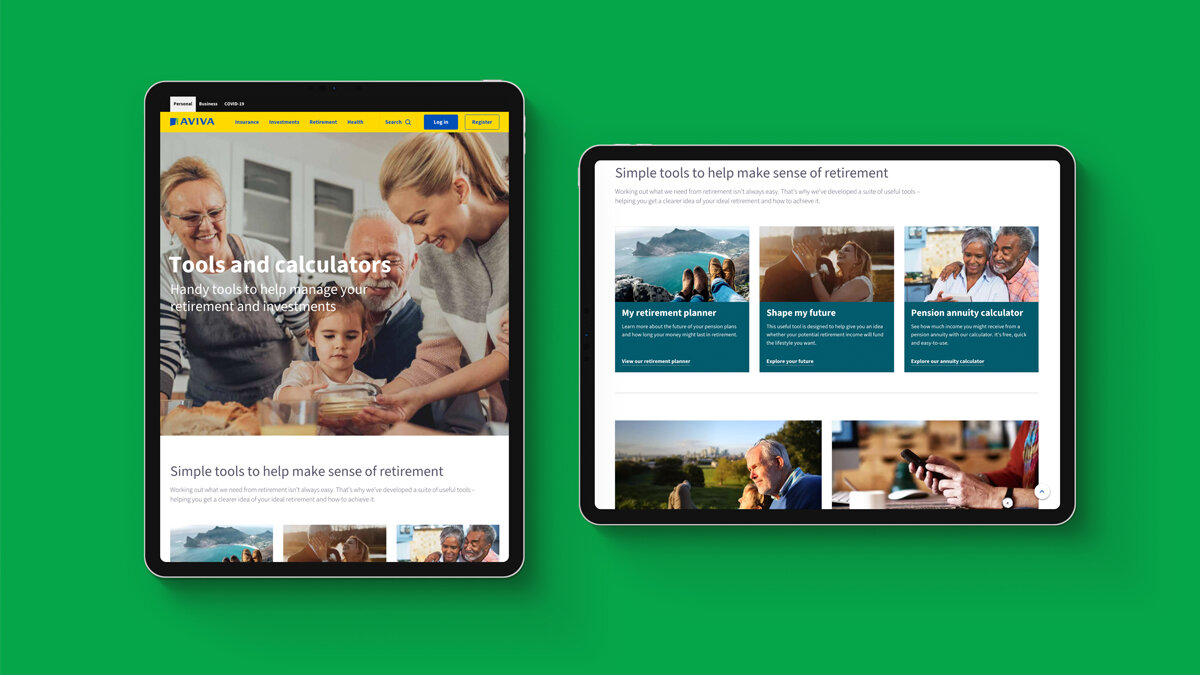
Aviva.co.uk digital estate redesign
How do you engage with a diverse customer base in the crowded financial services sector to provide meaningful digital independence?
Bringing a 320 year old business into the present
With 33 million customers across 16 countries, Aviva is one of the largest general insurer and life and pensions provider. A lot has changed in three centuries but the challenge of helping customers to prepare for the unexpected hasn’t. Aviva aims to be With you today, for a better tomorrow.
With this in mind, an improved digital estate was needed in order to be a major touchpoint for all customers as user needs and behaviours change.
Less uncertainty through digital independence.
So, who is the customer?
The insurance, life and pensions market is a relatively traditional space that can be confusing for customers to confidently engage with. Aviva recognised this and actively pursued to disrupt, stand out and simplify their offering.
It could be a 16-year-old new driver or a 101-year-old investor, the spectrum of Aviva customer types is vast. Each with different requirements, complex tasks and varying knowledge levels.
How can a single digital experience cater for all these needs at once?
Listen and listen again
The key to understanding how to approach the redesign was to speak directly with users, listening to their needs and wants, their frustrations, confusions and opinions. This was done through a series of depth interviews, direct customer feedback, live chat transcripts and focus groups.
Below is a flavour of the issues impacting on the user experience:
“Your website was not up to date enough to change my address, I had to do it over the phone!”
“Can’t cancel my renewal online. Have to phone and pay phone call charges to do that.”
"You sent me a letter to activate my account but I can’t locate the answers to my questions.”
Identifying user needs and wants
As much as the Aviva brand provides reassurance and strong credentials in the market, customers want and deserve more. Overcoming negative and sceptical barriers associated with the industry was key.
Below is an overview of the research findings:
Honesty
Customers want to know exactly what they are paying for and what that each product provides.
Accessibility
Catering for all users is no longer a second though and should be a paramount focus.
Clarity
The market is cluttered, both in terms of providers and policies which users find confusing.
Information
Users find that not all purchases are quick and want to be able to evaluated over time.
Autonomy
Users want to control their policies and investments to better suit ever changing needs.
Confusion
Concerns about choosing the wrong options, rendering a product unfit for purpose.
Loyalty
Customers want to be rewarded for being loyal and not penalised by missing out on offers.
Support
Provide clear and simple routes to support for questions that I may have relating to my policy.
Old Aviva.co.uk website
As part of the depth interviews with customers, we observed how individuals engaged with the existing website to better understand areas of failure.
These sessions were a mixture of task-orientated observations and group discussions which uncovered fantastic insight into the existing mental models each user had and the unique ways of navigating to information or functionality.
To be as conclusive as possible with the research approach we spoke with customers young and old, cost-sensitive and affluent, and those with additional needs and considerations.
What are users doing?
As much as the qualitative research shed light on what the customer wanted from a market-leading company, we also investigated the analytics to better understand the quantitative picture too.
How are users visiting the site? What do they do when there? And why?
54% of users visit the site via desktop or laptop device
The most common search engine used is Google with 80.3%
Only 2.3% of older users use a mobile device to visit the site
Frequently visited pages were Motor, Home, Travel, Life and Health
Users spend less time on pages but less likely to bounce
Tablet use peaks for users in their 50’s
Sunday is the most popular day for visiting users
Average engagement with hero banner promotions was 6%
Offers sitting higher up the page have a better click through rate
Universal customer mindsets
Throughout the user research phase, there were two clear and consistent mindsets that users aligned with that would ultimately inform the redesign.
The Soloist
This user knows exactly what they want and how to get it. They want a digital experience that allows them to quickly execute an action whenever they want.
The Validator
This user wants to take their time. Learn about a product or service and compare it against the market. They seek information, validation and proof points for ultimate consideration.
Creating a new experience to be proud of
Using a design sprint methodology, we focussed on working through several rounds of inspiration gathering, rapid ideation, prototyping and validation.
To ensure the customer was at the heart of this process at all times, we counter questioned each key decision and idea using the ‘5 whys’ approach and mirrored these ideas against Business, Customer and Brand goals to see where the strongest overlaps occurred.
Here is an overview of the design sprint detail and considerations:
How would we…? statements
Crazy 8 sketching
Narrow down common design themes
Clickable lo-fi prototyping
Goal evaluation
Competitor analysis - what works well and not well
Cross referenced ideas against Aviva global markets
Analogous inspiration - look far and wide
Hypothetic collaborations
Aspiration quadrant sketching

Bringing ideas to life
Armed with user insight, an array of ideas and testing knowledge, the next step was to start bringing the site to life through UX and visual design exploration.
Below is an overview of the features developed and why.
In-page navigation
To encourage content to be discovered and aid users who need to find specific information quickly, specifically on mobile devices.
Product feature signposting
To remove confusion around each product or service, features and detail were brought to life and made clearly visible through iconography.
Making the hard times easier
Demystifying the claims process for all products was key to generating user trust in times of need and supporting new customer choices.
Transparent policy detail
Removing the guessing game and stigma around hidden charges, the aim was to clearly show what is and isn’t included per product.
Clear proof points
Building user trust through visible product performance detail and the addition of a peer voice to relate with.
Virtual self-service at the touch of a button
Users want to ask questions and receive real-time responses 24/7 in order to gain knowledge or perform simple tasks.
From concept to delivery
A renewed digital experience requires a combination of user-centred skillsets and expertise in order to produce something that truly resonates with customer needs.
No stone was left unturned.
The following disciplines collaborated to deliver the redesigned digital estate for Aviva.co.uk:
Content design
Creation of a new content strategy that would better serve the identified user needs.
This would compliment the CMS underpinning the site build and inform the design thinking.
User centred design
Conducting the initial user research and design sprints to shape the design thinking.
Into the development of ideas, journeys, features, UI patterns and usability.
Product strategy
At all times providing clear direction on the market and the business goals and aims.
Ensuring what was delivered answered customer problems and added value to the business.
Development
Ultimate consistency via the Aviva Framework design system and Adobe Experience Manager.
The development team would create a solid platform that could be reused again and again.
Solid foundations for success
To go to market with a first-class experience that all customers could benefit from, we looked to drive re-usable consistency through the use of the Aviva Framework design system and Adobe Experience Manager.
In short, this meant that every journey, feature, UI pattern and overall experience, could be delivered quickly with confidence.
Safe in the knowledge that accessibility, usability and brand standards were baked in, it allowed for more time to concentrate on the customer experience. This included reducing content, using plain English and removing jargon, bringing product features to life, providing clear routes to support, demystifying policy detail, adding clarity to the claims process, and more.
Want to find out more about the Aviva Framework design system?


Customer needs simplified including claims process detail, online policy management, relevant decision making information, policy clarity, virtual help, peer reviews and much more.

The redesign content strategy, design thinking, UI patterns and approach to utilising a CMS were replicated across 9 global markets for Personal and Business products.

Dedicated customer advice hub covering key details across savings, investment and retirement products. Ensuring customers feel empowered through knowledge.

Dedicated tools and calculators were created to offer the customer more autonomy in decision making for specific products.
The impact and results
33.4 million
customers
Customer numbers rose by 2% within 12 months
84.4%
Digital Maturity ranking
Ranked number 1 in the 2020 FTSE 100 Digital Census.
27%
Net Promoter Score
These users would recommend Aviva to friends, family or colleagues.
90%
user success
Based on finding a range of products or information from the navigation using a tree test.
11.8%
site visit increase
Seen in week-on-week customer visits (1,047,073 visits, 47% direct).
x9
global markets
Redesign driving digital estates in the UK, Canada, Ireland, Singapore, Poland, France and more.

















